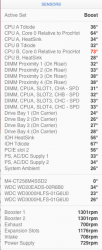I have a paid of X5690's in mine and if I reset the SMC and leave all my fans at default, my IOH Heatsink will also hover around 65C and be in the red with iStat. I have dealt with it by setting the min rpm of my intake/exhaust fans to 850 and that makes all the difference for me - at idle IOH Heatsink is now 56C and my two booster fans at idle are running at 1100rpm.
(Pro is 2009 -> 5,1)
Does this mean that X5690 equipped Mac Pro's will be louder than with something less (like X5670)?
Is the temp issue just with DUAL X5690's or would I have to raise the fan speed for a single X5690? I wanted to upgrade but not at the expense of a quiet Mac.


